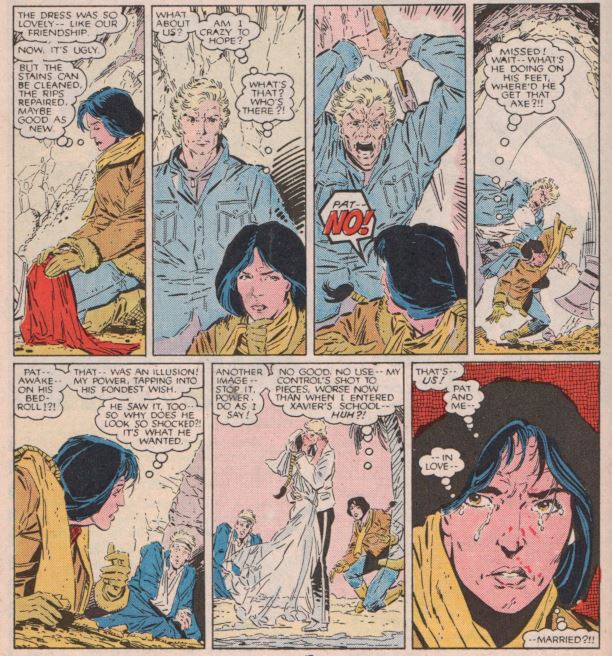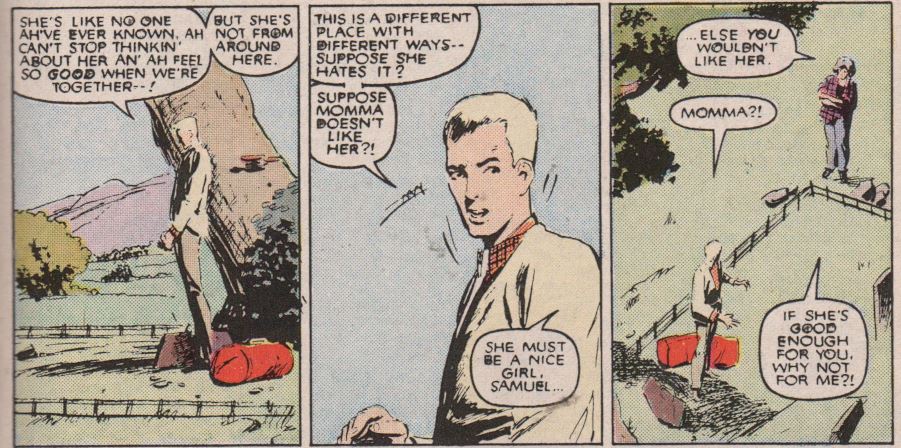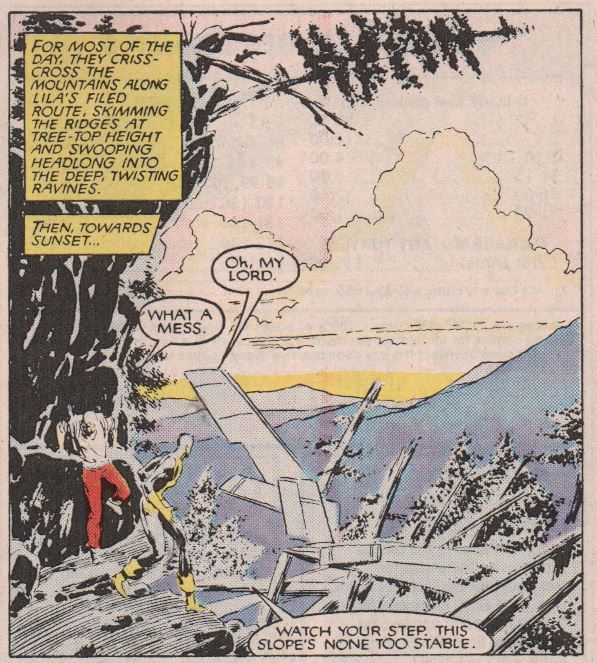TRAPPED IN HELL WITH THE NEW MUTANTS: PART ONE: NO DEMON BEAR IN SIGHT
A Hilarious Cycle of Capsule Reviews
Why am I doing this? Was this a good idea? How is this on The Comics Journal website? What’s the point of anything really? The preface might provide some answers, if you’re open-minded, if you’re chill, not a cop, cool, et cetera. ACAB: All Comics are Bullshit.
The first two issues of my New Mutants run are pretty good comics, but also pretty clearly filler. Not a ton going on to set them apart from an especially good Marvel comic of 1986, but plenty to appreciate compared to most. Writing about them, I somehow managed to trick myself into thinking these comics were very good, resonant even. They aren’t really? I’m susceptible to overpraising the likable qualities of a book like this, and having waded through this series a good bit and turning back to recap I’m getting a bit of X-stockholm syndrome. But that said, I don’t really feel like I’ve made anything up either.

THE NEW MUTANTS Vol. 1 No. 41, July, 1986.
STAN LEE PRESENTS “Way of the Warrior”
Chris Claremont, Writer
Jackson Guice, Breakdowns
Terry Austin, Finishes
Tom Orzechowski, Letterer
Glynis Oliver, Colorist
Ann Nocenti, Editor
Jim Shooter, Editor in Chief
New Mutants, Stars [I swear to god this credit is IN the comic! -Helen]
Published by MARVEL COMICS GROUP
Let’s start with the cover. Not bad! The brown, muted color scheme initially kind of underwhelmed me - this is a New Mutants cover, why are nobody’s eyes bugging out with shock? - but there’s a wonderful balance to it. The simple perspective is nice, I really like the way that the yellow and red aura around the pink-and-white blob shaded skeletal gunman seem to connect his stance to the burst of his pistols. The cover artist isn’t credited but after a few issues of similar work it became clear to me that it was none other than fave comics guy Barry Windsor-Smith. The minimal hatching Windsor-Smith uses in his inks here is very Euro Western, very Blueberry, if you told me Jean Giraud drew this during his lunch break while working on his Silver Surfer book, I’d believe you. The unmistakable blue and yellow of the X-Men uniform and the ridiculous and vaguely garbled drunk father sounding tagline “MIRAGE VS DEATH SHOWDOWN!” - I could imagine Tim Heidecker bellowing this on an On Cinema Oscar special - really gives it this absurdist yet dead serious air that iconic comic book covers should have. And it is legitimately cool and good to have a Native American woman as the protagonist of a western pastiche in a 1980s X-Men comic. For sure. Definitely a step above the workmanlike interiors, carried above basic legibility by the colorist with little in the way of idiosyncrasy.
Anyway, the comic was exactly what I expected, nothing crazy memorable, but at this point I was a happy camper and looking back on it this is a really strong issue. It’s one of those solo character issues between big events -- from what I hear out of the X-Men camp Claremont was really good at these, and he did kinda win me over here! This issue focuses on Mirage, A.K.A. Danielle Moonstar, a Native American girl VERY preoccupied with monologuing to herself about the hardships that the Cheyenne people have endured over generations at the hands of colonial white supremacy - which I mean, fair, honestly - and her power to generate an image of people’s deepest fears and innermost fantasies, or something, ESP, ya know, it’s 1986. Danielle has recently been gifted with a winged horse from “high-father Odin’s sacred herd,” Brightstar, and Danielle isn’t just honored as a horse girl, she’s achieved an incredible status as a Valkyrie. But as she narrates to us in her thoughts, she feels conflicted, and isn’t sure she had much of a choice. She's made extraordinary strides as a person through multiple grueling systems and made incredible achievements, but those systems have and will continue to represent the violent oppression of her people. This internal conflict will be brought up in multi-panel asides again and again in the issues to come, rather arbitrarily to the point of staleness, but there's no denying there's something powerful about her struggle with the implications of her own assimilation.

Like many a solo one-off adventure protagonist, Mirage zips around some MAJESTIC scenery before landing in her home town to visit her parents, and she is ACCEPTED by her FAMILY. The bulk of the comic is built around a CONFLICT from her YOUTH, a high school crush who has grown up to be a virulent racist white boy, a demeaning bully who does not deserve her sympathy. Unless…? It’s clearly an uncomfortable, traumatic relationship, and Claremont shifts awkwardly to avoid directly saying that it is nothing but raw, reasonless hatred that drove these two apart. I cringe a bit at the frequent implications via Mirage’s thoughts and narration that maybe there’s something else causing it, something that happened, some misunderstanding SHE could clear up. But whether or not the boy, Pat, is a sniveling racist, he is definitely in danger. Danielle can see it with her mutant power. As Mirage she literally does battle with death, a hackneyed psychic power conceit that nonetheless is ultimately very effective, the fears and fantasies both of her psyche and his overlap in confusion as the inevitable draws closer, brought to life as the gunslinger from the cover by Mirage’s dream-fueled abilities.

There never ends up being a moment where we get to find out a less ugly truth for why Pat grew up so hateful, although we get a fantasy where all that really warped him was a desire for her. Is this how he feels, or is it what Danielle wants? As Pat expires, Danielle’s vision of death shifts from gunslinger to tribal matriarch before falling away completely, and all we really know about this horrible, vulnerable man, as Danielle sobs to her parents, is that she wanted to save him. There’s some heavy stuff here, and Claremont frankly fumbles a lot but takes us to some pretty moving, vital places where more austere pop culture of the same vintage may not tread so willingly, without offering any answers firmer than the constant sadness of a world that works to remind you of your ongoing oppression and the inability to save people you used to think were strong themselves. I thought this was a good comic!

The real peak of this issue is a brief outing to the mall. It jives well with the issue’s major theme of conflict feeling any sort of little joy in a structure designed to oppress you and every little thing you hold dear, but also! I love shopping too!


THE NEW MUTANTS Vol. 1 No. 42, August, 1986.
STAN LEE PRESENTS “New Song for Old”
Chris Claremont, Writer
Jackson Guice, Breakdowns
Kyle Baker, Finishes
Tom Orzechowski, Letterer
Elaine Lee, Colorist
Ann Nocenti, Editor
Jim Shooter, Editor in Chief
Starring the New Mutants, created by Chris Claremont and Bob McLeod
Published by MARVEL COMICS GROUP
Another pretty cover, and the best issue yet. At this point I was feeling like I’d made a really good choice going with New Mutants as my bunker read, it’s definitely still the queerest issue thus far.
This issue is another solo character spotlight (these are pretty much always great huh? Another great thing about Fiffe’s Copra, bringing these kinds of stories back to serial comics), this time focused on Cannonball A.K.A. Sam Guthrie, who is a country boy, from The South, you see, because he does things like say “ah” when he says “I.” For what it's worth, he is also the best looking guy The New Mutants has to offer; if I had actually read these comics as a teen I would have had a crush. Cannonball is sort of the de facto team leader because he’s a white blond guy and comics are racist and sexist but uh kind of not actually not really -- Claremont never gives Cannonball disproportionate attention relative to the rest of the cast, I’m not sure whether this is Claremont’s much-touted penchant for diversity or his equally renowned lesbian fetish but honestly I appreciate the results of both intentions, it’s palpable and positive, and besides which, this issue is Cannonball’s time to shine.

If Cannonball has any privilege to check it is hot guy privilege, because he is dating a mutant pop star, Lila, who is sort of like Dazzler but new wave instead of disco and also more my vibe if I’m gonna level with ya. Don't get me wrong, Dazzler has a Tall Girl Energy which is pretty appealing but Lila has a better, more varied wardrobe and impeccably styled hair. Anyway. The driving conflict of this issue is Sam coming home to visit his family. He’s really uneasy about the way his mutant identity marks him out as different from his mother and younger brother (his father is dead), and especially anxious about bringing his trendy, urban, mutant girlfriend home to meet them. He fears his mother rejecting him, and his brother does lash out at him with truly hurtful prejudice, but his mother does accept him, with unconditional warmth, and his brother’s anger is adolescent confusion there is time to reach out. Sam/Cannonball’s fear comes from within. He persecutes his metropolitan life, loathes his mutant identity, pines self-destructively to assimilate in the comforting anonymity of home. Sam fears being recognized by the people who raised him as what he is because it would mean recognizing himself.

Sam takes out this internal struggle on Lila in some of the series’ most psychologically authentic moments - it was recognizable to me anyway. He distrusts her, reckons her callous, worries she won’t think to present respectfully to his mother to the point of actually having nightmares because he still clings to a contradictory prejudice of metrosexual mutant hedonism. He can’t imagine her understanding his cultural differences from her, he can’t imagine his mother understanding how she (and he) live out a different lifestyle from her own, he grows vindictive and paranoid of two people clashing in a way he cannot control and cannot quite name out loud because both lifestyles and identities somehow live in him too. Because this is a superhero comic this must be resolved with an act of one-sided heroism - a plane crash! Can Cannonball make it in time? (yes - see cover art) - but in terms of melodramatic allegory this climactic conflict is perfect because it brings together Sam’s contrasted cultural discomforts and forces him to reckon with what he really values, tearing through the paranoid suspicions that withheld him from embracing himself like so much rubble and twisted metal between hero and cool girlfriend. I don’t think I need to spell out why the whole thing smacked of gender to me, but if it doesn’t to you, maybe read a book ? It’s surprisingly moving, tender, recognizably humane storytelling in a series that even two solid floppies in I could tell was working out to be something of a fumbled, erratic hot mess.
Also wowee does Kyle Baker just KILL IT on interior finishes this issue or what? Baker inking another penciller and not his own work is a little hemmed in from the full-on cartooning force of his 80s work on, say, Damage Control or The Shadow, but what you get instead is something stylistically on par with Klaus Janson inking himself, but with a greater emphasis on conveying emotional interiority. Baker’s expressive mark-making over Guice’s workman pencils has this moody pseudo-naturalism and high-contrast pop to it, bringing a dynamism even to more quiet, static dialogue scenes that enhances Guice’s often easy-to-miss knack for framing and pacing a sequence. Baker’s thick dark brush strokes and command of negative space carve out vividly defined shadows and textures that you just know make a farm boy look good and sad when they veil his face in somber darkness in an emotional scene...good job Kyle! Sells some compositions that would have been reeeally hackneyed in a less skilled inkers hands. Also, Elaine Lee’s colors are spectacular. There’s a lot of light, creamy shades that still suggest broody, dimly-lit atmosphere -- the pale greens and blues for the southern gothic of Sam’s hometown are really effective. With such sensitivity, those deep, solid yellows and reds deployed when Cannonball uses his powers as well as in the backgrounds of key frames - very thematically appropriate - absolutely pop. The palette is largely consistent with the rest of the series, but it stands out more by the sheer craft of these inviting compositions...this is an excellent comic, especially for what it is. Still very wordy tho, don’t have much love for Claremont’s writerly tics. Comics is a special medium because I can stare at a lovely page sometimes and not care that I sorta hated reading it.

---
After this I hit my first gap in numbering - I don’t have issue 43. I also realized that I had issues 36 and 37 as well and hadn’t read them yet. These two issues both alert me via a subtle triangle on the upper right hand of the cover that SECRET WARS II CONTINUES IN THIS ISSUE! So obviously I had to dip back and find out what was going on during one of those Secret Wars, two.
---
NEXT TIME IN HELL: What were those secret wars? Why were there two of them? Why is Bill Sienkiewicz here? Is Claremont horny? Stay Tuned!






